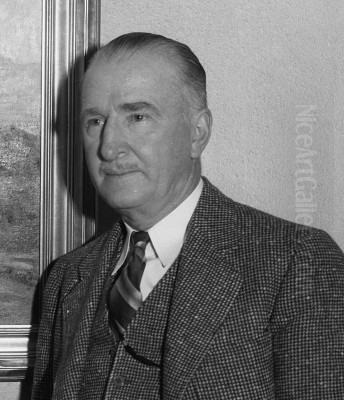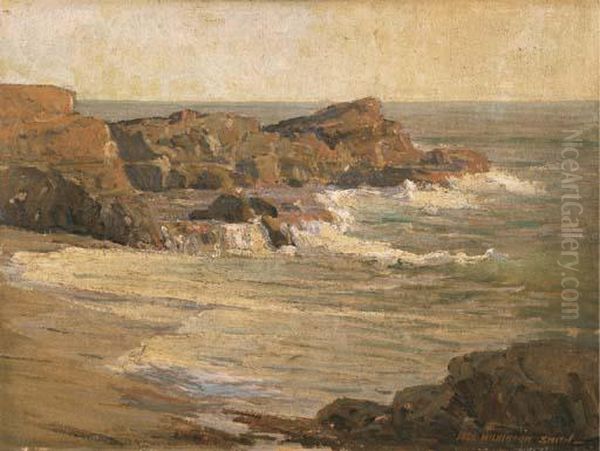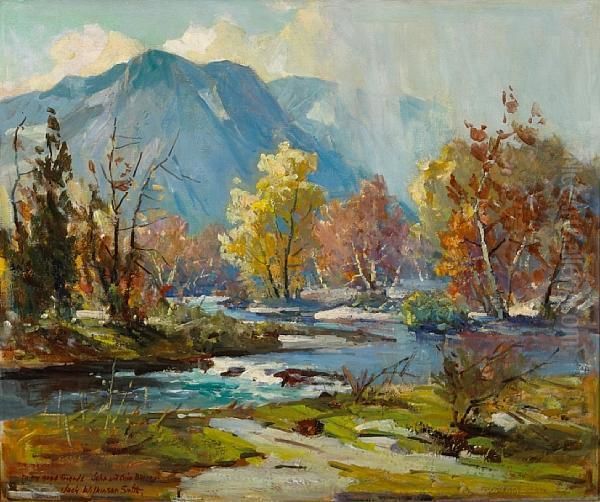
Jack Wilkinson Smith (1873-1949) stands as a significant figure in American art, particularly celebrated for his contributions to the California Impressionist movement. His artistic journey was one of remarkable versatility, beginning with gritty front-line sketches that captured national attention and culminating in luminous depictions of the Pacific coast and the majestic Sierra Nevada mountains. Smith's life and work offer a fascinating window into the evolving American art scene at the turn of the 20th century and the burgeoning cultural landscape of Southern California.
Early Life and Artistic Awakening
Born in Paterson, New Jersey, in 1873, John Wilkinson Smith (he would later be known as Jack) was immersed in an artistic environment from a young age. His father, a decorative painter, undertook significant commissions, including work on the New York State Capitol in Albany. This paternal influence undoubtedly played a role in nurturing young Jack's nascent interest in art, providing him with an early, firsthand glimpse into the life of a working artist and the transformative power of visual expression.
The late 19th century was a period of dynamic change in American art. While traditional academic styles still held sway, new currents, particularly Impressionism from Europe, were beginning to make their mark. Artists were increasingly exploring American subjects and landscapes, seeking to forge a distinctly national artistic identity. It was within this stimulating context that Smith began his formal artistic training.
Formative Years and a Nation's Call
Smith's formal art education commenced at the prestigious Art Institute of Chicago. Here, he studied under Gardner Symons, a notable American Impressionist painter known for his snow scenes and landscapes. Symons, who himself had studied in Paris and was influenced by European Impressionism, would have exposed Smith to modern techniques of capturing light and color, emphasizing plein air (outdoor) painting. This period in Chicago provided Smith with a solid foundation in drawing and painting, honing his observational skills and technical proficiency.

Seeking to further refine his craft, Smith later moved to Cincinnati, Ohio. He enrolled in the Cincinnati Art Academy, studying under the influential artist and teacher Frank Duveneck. Duveneck, renowned for his vigorous brushwork and dark, rich palette influenced by the Old Masters and the Munich School, offered a different, yet equally valuable, perspective. His emphasis on direct painting and capturing the character of the subject would have complemented Smith's earlier training.
During his time in Cincinnati, Smith put his artistic skills to practical use, working as a sketch artist for the Cincinnati Enquirer. This role was not merely a job; it was an apprenticeship in rapid observation and visual storytelling. The ability to quickly capture the essence of a scene or event was paramount for newspaper illustrators before photography became widespread in print media. He also worked for a period as a commercial artist in Lexington, Kentucky, further diversifying his experience.
The pivotal moment in Smith's early career arrived with the outbreak of the Spanish-American War in 1898. His talent for swift and evocative sketching earned him a position as a front-line illustrator. His vivid depictions of the conflict, dispatched from the heart of the action, were published in newspapers across the country, bringing him national recognition. These war sketches demonstrated his courage, his keen eye for detail under pressure, and his ability to convey the human drama of conflict, prefiguring the work of later war artists. This experience, though far removed from the tranquil landscapes he would later become famous for, undoubtedly sharpened his skills and broadened his understanding of the human condition.
The Lure of the West: California Beckons
The dawn of the 20th century saw a significant migration of artists towards California. The state's diverse and dramatic landscapes, its unique quality of light, and its burgeoning cultural centers proved an irresistible draw. In 1906, Jack Wilkinson Smith joined this westward movement, relocating to Los Angeles. This decision marked a turning point in his artistic trajectory, leading him away from illustration and commercial work towards a dedicated career as a fine art painter.
He established a studio in Alhambra, a town on the outskirts of Los Angeles that was becoming a haven for artists. This "Artists' Alley," as it was sometimes known, fostered a collegial atmosphere where painters could exchange ideas and find mutual support. Among his neighbors and colleagues in this creative enclave were figures like Eli Harvey, a noted sculptor and painter, and Frank Tenney Johnson, who would become famous for his moonlit nocturnes of the American West.

In California, Smith fully embraced oil painting, a medium that allowed him to explore the rich colors and textures of his new surroundings. While he had worked in watercolor in the Midwest, the brilliant California light and the grand scale of its scenery seemed to demand the expressive power of oils. His focus shifted decisively to landscape and seascape painting, subjects that would define his mature career.
Capturing the Golden State: Style and Subject Matter
Jack Wilkinson Smith is best known for his masterful depictions of the California landscape, from its rugged coastline to the towering peaks of the Sierra Nevada. His style is firmly rooted in Impressionism, characterized by a concern for capturing the fleeting effects of light and atmosphere, broken brushwork, and a vibrant palette. However, his work also retained a strong sense of underlying structure and a fidelity to the natural forms he observed, distinguishing him from more abstract interpretations of Impressionism.
His seascapes often portray the dramatic meeting of land and water along the Pacific coast, particularly around Laguna Beach and Carmel. Works like The Joy of the Sea or Laguna Coast (titles representative of his oeuvre) capture the crashing surf, the mist-laden air, and the warm glow of sunlight on cliffs and sand. He had a remarkable ability to convey the power and movement of the ocean, as well as its more tranquil moods. His palette for these coastal scenes often featured brilliant blues, greens, and ochres, applied with a confident and energetic hand.
Equally compelling were his paintings of California's interior, especially the Sierra Nevada mountain range. Smith made numerous sketching trips into the high country, seeking out remote and inspiring vistas. His mountain landscapes, such as the descriptively titled Sierra Slopes, convey the grandeur and solitude of these alpine environments. He skillfully rendered the play of light on granite peaks, the deep blues of mountain lakes, and the varied greens of pine forests. These works often evoke a sense of awe and reverence for the natural world, a common sentiment among California Impressionists who saw the landscape as a source of spiritual renewal. Other notable works that showcase his talent include California Spring, capturing the vibrant bloom of wildflowers.
Smith's approach involved both plein air sketching and studio work. He would often make smaller studies outdoors to capture the immediate impressions of light and color, later developing these into larger, more finished canvases in his Alhambra studio. This practice allowed him to combine the spontaneity of direct observation with more considered composition and refinement.
A Pillar of the Art Community
Beyond his personal artistic pursuits, Jack Wilkinson Smith was an active and influential member of the burgeoning Southern California art community. He was a key figure in the Laguna Beach Art Association, one of the most important artists' organizations on the West Coast. Founded in 1918, the association provided a venue for exhibitions, fostered camaraderie among artists, and played a crucial role in establishing Laguna Beach as a significant art colony, a status it shares with other California art centers like Carmel-by-the-Sea, which attracted artists like William Ritschel and Armin Hansen.
Smith's commitment to fostering a vibrant art scene extended to Los Angeles itself. He was instrumental in the founding of the Biltmore Salon, located within the prestigious Biltmore Hotel. This gallery became a leading venue for showcasing the work of California artists and helped to cultivate a market for their paintings. Smith served as its first resident artist, a testament to his standing among his peers. The Biltmore Salon was a cooperative venture, eventually involving around sixteen other artists, demonstrating a collaborative spirit aimed at promoting regional art. His involvement with such organizations, as well as memberships in groups like the Academy of Western Painters, the Allied Artists, and the esteemed Salmagundi Club of New York, underscores his dedication to the professional advancement of artists and the appreciation of their work.
The "Artists' Alley" in Alhambra, where Smith resided, was more than just a collection of studios; it was a dynamic community. The proximity of artists like Eli Harvey and Frank Tenney Johnson facilitated an ongoing exchange of ideas and techniques. This environment was crucial for the development of what became known as California Impressionism, a regional interpretation of the broader Impressionist movement, characterized by its bright palette and focus on the unique light and landscapes of the state.
Contemporaries and Collaborations
Jack Wilkinson Smith's career unfolded alongside a remarkable generation of California artists. He formed strong friendships and professional associations with many of them. Among his close associates were Hanson Puthuff, another prominent landscape painter known for his depictions of California's hills and deserts, and William Wendt, often dubbed the "dean" of Southern California landscape painters for his powerful, structured portrayals of the state's natural beauty. While Wendt's style was perhaps more robust and less overtly Impressionistic than Smith's, both men shared a deep love for the California landscape and were pivotal in shaping the region's artistic identity.
His circle also included artists like Charles P. Austin and Clyde Forsythe, the latter known for his desert landscapes and Western scenes. The camaraderie among these painters was often expressed through shared sketching trips and participation in group exhibitions. These interactions fostered a sense of shared purpose and contributed to the distinctive character of California art during this period. Other notable California Impressionists active during Smith's time, forming the broader artistic milieu, included Guy Rose, who brought a direct experience of French Impressionism from Giverny, Granville Redmond, known for his vibrant poppy fields and nocturnes, and Edgar Payne, celebrated for his dramatic Sierra Nevada and coastal scenes, as well as Maurice Braun with his distinct Theosophist-influenced landscapes.
Smith also maintained connections with artists beyond the California school. His earlier acquaintance with figures like Howard Chandler Christy and Charles Dana Gibson, both celebrated illustrators of national renown, speaks to his broader engagement with the American art world. Christy, known for his "Christy Girl," and Gibson, creator of the "Gibson Girl," were giants of illustration, and their paths likely crossed Smith's during his earlier career or through national art organizations. These connections highlight the interconnectedness of the art world, even across different genres and geographical locations. The competitive aspect, while perhaps not overtly hostile, would have naturally existed as artists vied for recognition, patrons, and prime exhibition space, pushing each other to refine their styles and produce their best work.
Beyond the Canvas: Photography and Plein Air
While primarily known as a painter, Jack Wilkinson Smith's artistic practice was not confined to the brush and canvas. He was also involved in photography, a medium that was gaining increasing recognition as an art form during his lifetime. For a landscape painter, photography could serve multiple purposes: as a tool for recording visual information, as an aid to composition, or as an independent means of artistic expression. While details of his photographic work are less documented than his paintings, his engagement with this medium reflects a broader interest in visual representation and the technological advancements of his time.
His dedication to plein air painting was a cornerstone of his artistic philosophy. The practice of painting outdoors, directly in front of the subject, was central to Impressionism. It allowed artists to capture the immediate and often fleeting effects of light and atmosphere that were so crucial to their aesthetic. Smith's numerous sketching expeditions, whether to the rugged coastline or the remote Sierra peaks, attest to his commitment to this immersive approach. This dedication to outdoor work connected him to a long tradition of landscape painters, from the Barbizon School in France to American masters like Winslow Homer and Thomas Moran, who also sought direct engagement with nature.
Later Years and Enduring Legacy
Jack Wilkinson Smith continued to paint and exhibit throughout his life, remaining an active and respected figure in the California art scene until his passing in 1949 in Monterey Park, California. His work was widely collected during his lifetime and has continued to be sought after by art enthusiasts and collectors of California Impressionism.
His artistic contributions were multifaceted. As a skilled draftsman and painter, he created a significant body of work that beautifully captures the diverse landscapes of California. His paintings are celebrated for their vibrant color, their sensitivity to light, and their ability to evoke the unique atmosphere of the Golden State. He was a pioneer of the California Impressionist movement, helping to define its characteristic style and subject matter.
Some observations from his time, such as a critique noted from the 1930s regarding frequent changes in subject matter while at his Alhambra studio, might be interpreted less as "instability" and more as an artist's exploration or response to varied commissions or inspirations. Similarly, descriptions of his later life or style as "eccentric" by some contemporaries are subjective and common in artistic circles, often reflecting a strong individual personality rather than a significant controversy. His marriage to Emma Troop, an art educator, further rooted him in the artistic and educational fabric of Los Angeles.
The true measure of his legacy lies in the enduring appeal of his paintings and his role in establishing a vibrant art community in Southern California. His work is represented in numerous private and public collections, and exhibitions of California Impressionism frequently feature his canvases. Artists like Smith, through their dedication to their craft and their passion for their chosen landscapes, helped to create a rich artistic heritage for California and for American art as a whole.
Conclusion
Jack Wilkinson Smith's journey from the battlefields of the Spanish-American War to the sun-drenched landscapes of California is a testament to his adaptability and his profound connection to the visual world. He successfully transitioned from a promising illustrator to a leading figure in the California Impressionist movement, leaving behind a legacy of paintings that continue to enchant viewers with their beauty and their heartfelt depiction of the American West. His role as a community builder, fostering artistic talent and promoting regional art through organizations like the Laguna Beach Art Association and the Biltmore Salon, further solidifies his importance. Jack Wilkinson Smith remains a key artist for understanding the development of American Impressionism and the rich artistic tapestry of early 20th-century California. His life's work serves as an enduring celebration of natural beauty, captured with a skilled hand and an artist's discerning eye.